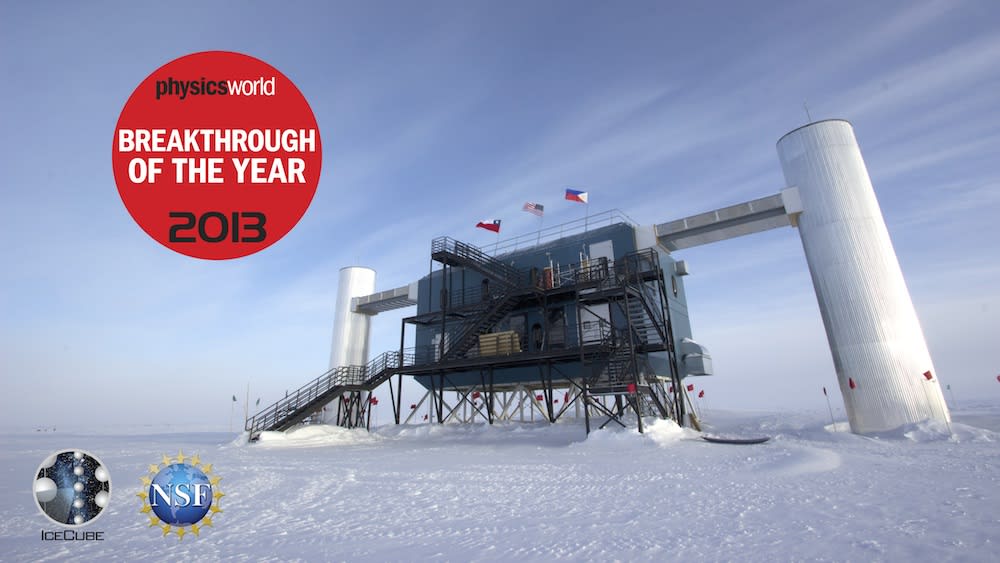
The IceCube project has been awarded the 2013 Breakthrough of the Year by the British magazine Physics World. The Antarctic observatory has been selected for making the first observation of cosmic neutrinos, but also for overcoming the many challenges of creating and operating a colossal detector deep under the ice at the South Pole.
“The ability to detect cosmic neutrinos is a remarkable achievement that gives astronomers a completely new way of studying the cosmos,” says Hamish Johnston, editor of physicsworld.com. “The judges of the 2013 award were also impressed with the IceCube collaboration’s ability to build and operate a huge and extremely sensitive detector in the most remote and inhospitable place on Earth.”
The IceCube Neutrino Observatory was completed in December 2010, after seven years of construction at the South Pole. But the idea of a huge detector buried in the ice was conceived a long time ago. Back in the 1990s, the AMANDA detector was built as a proof of concept for IceCube. By January 2005, the first sensors of IceCube had already reached 2,450 meters below the Antarctic ice sheet. It was only a few weeks ago that the IceCube Collaboration published in Science the first evidence for a very high-energy astrophysical neutrino flux, opening a new era in astronomy.
“I did not imagine that the science would be as exciting as building this detector. Challenges were many, from deciphering the optical properties of ice that we have never seen to drilling a hole to 2.5 kilometers in 2 days, and then repeating 86 times. Only the dedication of very talented individuals made this possible,” says Francis Halzen, principal investigator of IceCube and the Hilldale and Gregory Breit Professor of Physics at the University of Wisconsin–Madison.
As Prof. Halzen first envisioned, the ice became the perfect medium to search for very high-energy neutrinos that, after travelling through the universe during millions—even billions—of years, haphazardly interact with the nucleus of a molecule of ice.
“The success of IceCube builds on the efforts of hundreds of collaborators around the world—from the design, the deployment in a harsh environment and the AMANDA prototype to data harvesting and physics analysis. The top breakthrough of the year award is a superb way to ultimately honor these efforts,” adds Olga Botner, IceCube spokesperson and physics professor at Uppsala University.
“We made the impossible seem easy,” can be read on a wall at UW–Madison, quoting one of the driller technicians who helped make this telescope a reality. One challenge after another was overcome, and once the full detector was operational, the science results were even more incredible. The first neutrinos from outer space have been observed, and IceCube is honored to head the list of 2013 physics breakthroughs, but the best might be yet to come.
IceCube is comprised of 5,160 digital optical modules suspended along 86 strings (cables) embedded in a cubic kilometer of ice beneath the South Pole. It detects neutrinos through the tiny flashes of blue light, called Cherenkov light, produced when neutrinos interact in the ice.
The IceCube Neutrino Observatory was built under an NSF Major Research Equipment and Facilities Construction grant, with assistance from partner funding agencies around the world. The project continues with support from a Maintenance and Operations grant from the NSF’s Division of Polar Programs and Physics Division, along with international support from participating institutions and their funding agencies. UW–Madison is the lead institution, and the international collaboration includes 275 physicists and engineers from the U.S., Germany, Sweden, Belgium, Switzerland, Japan, Canada, New Zealand, Australia, U.K., Korea and Denmark.
Contacts:
Francis Halzen, PI IceCube
Hilldale and Gregory Breit Distinguished Professor of Physics
University of Wisconsin-Madison
francis.halzen@icecube.wisc.edu
Olga Botner, IceCube Spokesperson
Professor of Physics
University of Uppsala
olga.botner@physics.uu.se
Note: A multimedia gallery is available at here.
Read the release about the “Evidence for High-Energy Extraterrestrial Neutrinos at the IceCube Detector” published in Science